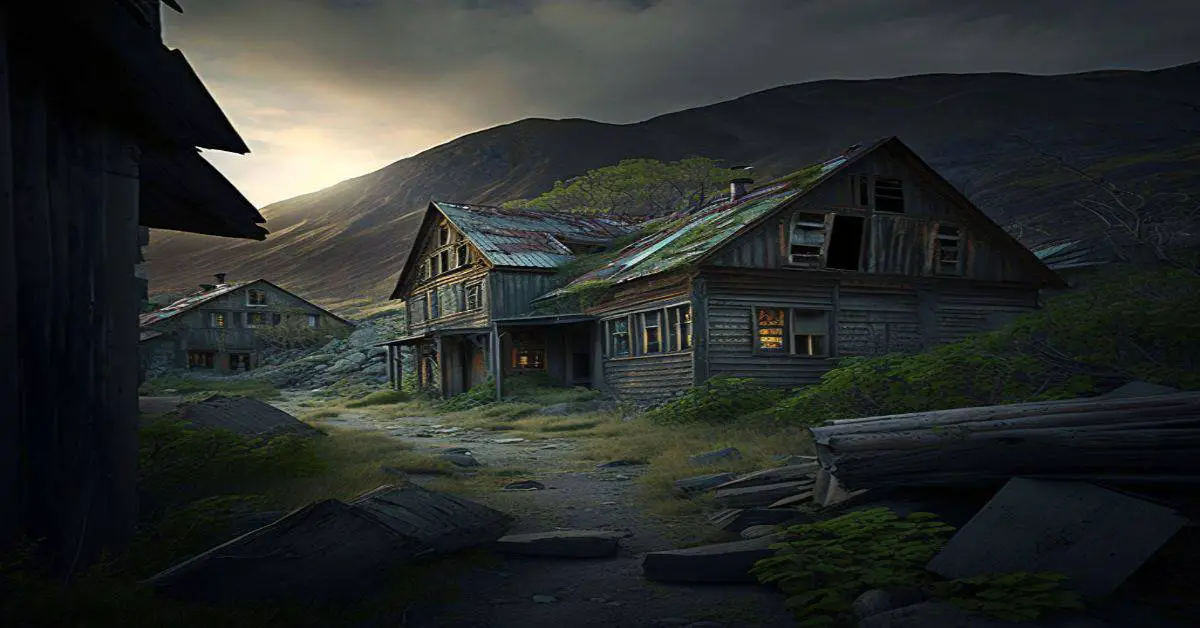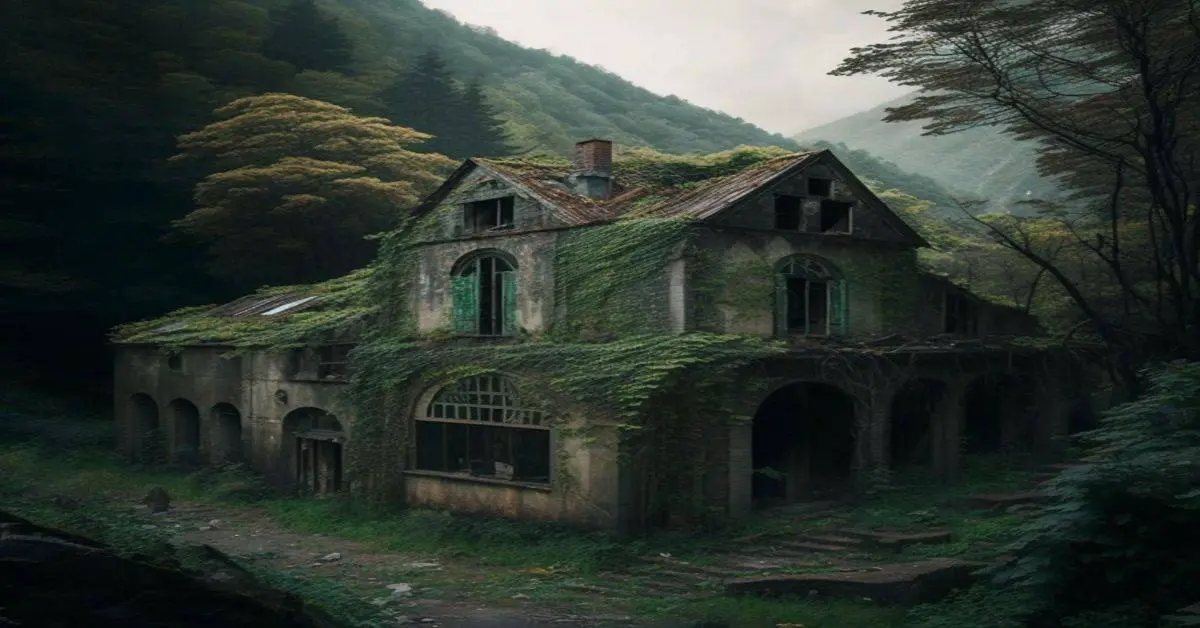You’ll find Jennings, Michigan as one of the state’s most dramatic ghost town stories. Founded in 1883 as a lumber boomtown, it once thrived with 2,000 residents before its rapid decline in the early 1900s. When timber resources dwindled, the Mitchell Brothers orchestrated an unprecedented relocation of nearly 70 homes to Cadillac. Today, you can explore scattered Victorian remnants and one original church along Crooked Lake, where nature steadily reclaims this shadow town’s fascinating past.
Key Takeaways
- Jennings transformed from a thriving lumber town of 2,000 residents to Michigan’s largest ghost town following timber depletion in the early 1900s.
- Nearly 70 homes were relocated from Jennings to Cadillac when the Mitchell Brothers’ logging operations ceased.
- The town’s population dropped dramatically to under 50 residents by the 1930s as the lumber industry declined.
- Modern-day Jennings retains scattered Victorian homes, weathered street signs, and one original church amid largely abandoned downtown blocks.
- Despite its ghost town status, Jennings maintains a small population, earning it the nickname “shadow town” with Crooked Lake nearby.
The Birth of a Logging Empire
When lumbermen Austin and William Mitchell established their settlement in 1883, they laid the foundation for what would become a thriving logging empire in northern Michigan.
You’d have found their bustling lumber company and sawmills dotting the shores of Crooked Lake, where logging techniques mirrored the industry’s best practices of winter harvesting and spring river drives.
The Mitchell brothers followed the common practice of the era, as few roads existed and their logging camps had to be built to house crews deep in the forests.
The town later changed its name to Jennings in 1890 to avoid confusion with another Mitchell, making it the namesake of William Jennings Bryan.
From Mitchell to Jennings: A Town’s Evolution
As the Mitchell brothers’ logging empire took root along Crooked Lake, their namesake settlement underwent a significant transformation in identity.
You’d find the town’s original name, “Mitchell,” stamped on early maps from 1883, honoring Austin and William Mitchell’s lumber company that birthed the community.
The town was eventually renamed to Jennings in 1890, marking a new chapter in its evolution. The community flourished with the establishment of multiple mills situated along Crooked Lake’s shores.
Life in the Lumber Boom Years
During the lumber boom of the late 1800s, Jennings transformed from a modest settlement into a bustling company town of 2,000 residents, powered by the Mitchell Brothers’ ambitious purchase of 50 million feet of timber.
Lumber lifestyles centered around the mill, where you’d find workers living in company-owned homes while maneuvering the demanding rhythms of timber production. The abundant pine and hardwood trees in the Upper Peninsula provided the raw materials that kept the mills running.
You’d face seasonal challenges head-on – swatting mosquitoes in sweltering summers and battling harsh winters. The Mitchell Brothers provided decent housing, while general stores and basic amenities popped up to serve the growing community.
Despite the hardships, you could earn a living in the sawmills or logging camps, though the work was grueling.
Ice harvesting from Jennings Lake offered additional winter employment, helping you piece together a year-round income in this thriving lumber town.
Finnish Heritage and Cultural Legacy
While Jennings drew workers from various backgrounds, Finnish immigrants left an especially deep mark on Michigan’s cultural landscape.
If you’d visited the region during the early 1900s, you would’ve found tight-knit Finnish communities maintaining their cultural identity through language halls, cooperative stores, and temperance societies. These “language islands” helped preserve Finnish traditions and the Finnish language well into the 1950s.
Laestadian Lutheran leaders actively encouraged their followers to pursue farming over industrial work, viewing agriculture as a more virtuous path.
The Swede-Finnish lumber workers found employment in the area’s thriving timber industry before many transitioned to mining and farming work. You can still see evidence of this heritage today in the Upper Peninsula’s place names like Nisula and Toivola.
The Finnish influence is most visible in the old farmhouses with their adjacent saunas – a cherished tradition brought from the homeland. Churches and social halls once served as vibrant centers for Finnish music, dance, and celebrations like the Juhannus midsummer festival.
The Great House Migration to Cadillac
Since timber resources around Jennings had begun to dwindle in the early 1900s, an unprecedented solution emerged to address both Jennings’ decline and Cadillac’s housing shortage. You’ll find it remarkable that 143 entire houses were physically moved the ten miles between towns, showcasing extraordinary community resilience during this industrial shift.
The house logistics were revolutionary for their time. Mitchell Brothers Lumber collaborated with Acme Truck Company to design special low-slung trailers capable of transporting complete homes. This innovative approach helped preserve neighborhood ties rather than scatter residents. The Clam Lake Canal enabled efficient transportation of building materials between the towns during the relocation effort. Detroit-based General Motors Corporation had acquired Cadillac in 1909, bringing significant industrial growth to the region.
While Jennings’ mills were downsizing, Cadillac’s lumber industry was thriving and needed workers. The mass relocation not only solved Cadillac’s housing crunch but also maintained social connections as entire communities relocated together, demonstrating the adaptability of these early 20th-century residents.
Landmarks Lost to Time
As time marched forward, Jennings’ once-bustling streets gradually surrendered to nature’s reclamation, leaving only sparse remnants of its vibrant past.
If you visit today, you’ll find just one church standing where four once served diverse congregations, a symbol of lost architecture and fading community memories.
Like many Michigan communities affected by economic shifts, Jennings saw its population dwindle as jobs disappeared and residents sought opportunities elsewhere.
The town’s original downtown blocks, though vacant, still hint at Jennings’ former prominence.
You won’t find the hotel, town hall, livery, saloon, or pool hall – they’ve all vanished.
Only scattered foundations mark where company homes once housed workers, while Main Street retains faint traces of its early 1900s glory.
Nature has steadily reclaimed the land, with overgrowth obscuring old street signs and building sites, while Crooked Lake’s shoreline bears little evidence of its industrial past.
Chronicles of the Mitchell Brothers
You’ll find the Mitchell brothers’ story begins in 1883 when they founded a lumber town initially called Mitchell, purchasing 50 million feet of timber and building a massive sawmill that would employ up to 600 men.
Their company town grew rapidly, with the brothers owning most homes and operating the mill around the clock while connecting their enterprise to broader markets through the Jennings & Northeastern Railroad.
When timber resources dwindled in the 1920s, you’d have witnessed an extraordinary sight as the Mitchell brothers orchestrated the physical relocation of about 70 houses to Cadillac, with some residents remarkably riding inside their homes during the move.
Founding a Logging Empire
When the Mitchell Brothers established their lumber empire in northern Michigan, they began with a strategic vision that would shape the region’s timber industry for decades to come. Their logging strategies focused on acquiring prime pine lands and positioning operations near waterways for efficient transport. Through partnerships with industry leaders like Jonathon W. Cobbs, they’d build a formidable presence in lumber production.
- You’ll find they controlled 276 acres of initial pine land, expanding to 50 million feet of timber in Missaukee County by 1882.
- They built a modern mill in Cadillac capable of producing 80,000 feet of lumber daily.
- Their operations included up to 28 lumber camps across northern Michigan.
- They constructed their own railroad network from Boyne Falls to Chandler Township.
- They drew workers from across the Northeast, Canada, and Scandinavia, creating a diverse workforce.
Moving Town to Cadillac
The Mitchell brothers orchestrated one of Michigan’s most remarkable mass relocations in the early 1900s by moving nearly 70 of Jennings’ finest homes to Cadillac, ten miles away.
As the lumber industry declined, they shifted their operations and convinced residents to follow. You’d have witnessed an extraordinary sight: entire houses rolling down widened roads, with some brave souls even riding inside during transport.
The house transportation created lasting changes to both communities. In Cadillac, particularly along Granite Street’s south end, you can still spot these relocated homes today.
Meanwhile, Jennings experienced dramatic community displacement, its population plummeting to under 50 by the 1930s. What remained was a ghost town of empty lots and abandoned structures – a stark reminder of how quickly a company town’s fortunes could change.
A Town’s Transformation Into History
Along Crooked Lake’s shore, Jennings’ transformation from a bustling lumber town into Michigan’s largest ghost town unfolded through a series of dramatic changes in the early 1900s.
The ghost town dynamics reflected the harsh realities of economic decline, as Jennings witnessed its population plummet from 1,200 to mere handfuls of residents by mid-century.
- The town’s dependence on lumber proved fatal once timber resources depleted.
- Local businesses shuttered one by one, from the bustling hotel to the lively pool hall.
- Community institutions faded, leaving just one church standing where four once served.
- Company housing emptied as workers sought opportunities elsewhere.
- The town earned its “shadow town” nickname, as scattered residents still call it home despite its ghost town status.
Modern Day Traces and Remnants
Modern visitors to Jennings discover a striking contrast between past glory and present-day remnants, where scattered Victorian homes and weathered street signs hint at the town’s former liveliness.
Time-worn Victorian architecture and faded signs stand as silent witnesses to Jennings’ vibrant past, now frozen in melancholy beauty.
You’ll find downtown blocks still visibly intact, though largely abandoned, with only one of the original four churches standing as a monument to bygone days.
As you explore, you’ll notice nature steadily reclaiming the ghost town’s footprint. Crooked Lake remains a defining feature, while forest vegetation creeps over vacant lots and old foundations.
Along M-55, you can spot repurposed Victorian buildings now serving as bait shops and stores. While most residents have long since departed, a handful of people still call this shadow town home, preserving fragments of its logging-era heritage amid the quiet solitude.
Frequently Asked Questions
Were Any Famous People Besides William Jennings Bryan Associated With Jennings?
Besides Bryan, you won’t find famous residents or historical figures linked to the town except the Mitchell brothers, who founded and controlled it through their lumber operations.
What Happened to the Indigenous Populations in the Jennings Area?
Picture your home burning as men force you out: That’s what Burt Lake Band indigenous people endured. You’d lose your legally purchased lands through unjust taxes, destroying cultural heritage and ancestral connections.
How Did the Great Depression Affect Jennings Compared to Other Towns?
You’d find the economic decline hit harder in small towns like Jennings due to limited industry diversity, while larger Michigan cities showed more community resilience through varied employment options and organized relief efforts.
Did Any Significant Crimes or Mysteries Occur in Jennings?
Like a quiet lake at dawn, you won’t find ripples of unsolved mysteries or dark local legends here. Historical records show no significant crimes in Jennings beyond typical small-town incidents of the logging era.
What Natural Disasters Besides Fires Impacted the Town’s Development?
While you won’t find records of major catastrophes, the town’s location near Crooked Lake exposed it to ongoing flood damage and water-related issues that gradually wore down infrastructure and hindered economic recovery efforts.
References
- https://99wfmk.com/jennings-2021/
- https://www.nailhed.com/2017/10/the-ghost-town-that-moved.html
- https://www.geocaching.com/geocache/GC7YWNM
- https://www.youtube.com/watch?v=AaBZ1QCGbuY
- https://99wfmk.com/jenningsghosttown2018/
- https://msaf.forest.mtu.edu/ForestInfo/MSUElibrary/LumberingInMichigan.PDF
- https://mff.forest.mtu.edu/TreeBasics/History/LogEra.htm
- https://y105music.com/jennings-michigan-ghost-town/
- https://www.youtube.com/watch?v=se0KF6YpcXI
- https://www.cadl.org/lhonline/Lawlers Lansing History Timeline 1.pdf


